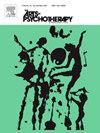Integrating community art therapy with psychoanalysis
IF 1.5
3区 心理学
Q3 PSYCHOLOGY, CLINICAL
引用次数: 0
Abstract
Community art therapy and art psychotherapy are often seen as opposing approaches. Psychoanalytic work traditionally focuses on the internal world of the individual and the ways in which these impacts on the outside world - behaviour, perceptions, reactions and, understanding. In contrast, community work is considered socially engaged work with a focus on the collective, society, and culture with their impact on the individual or group. These two aspects may be difficult to reconcile but a purposeful combination of both can promote an integrative and holistic reconciliation of art therapy. In this paper, the authors discuss three aspects of community art therapy that resonate with contemporary psychodynamic concepts. The primacy of the therapeutic relationship (psychotherapy) pertains to belonging (community), insight oriented approach (psychotherapy) to responsiveness to participant goals (community) and work with the unconscious as in the collective shadow (psychodynamic) as related to social awareness of systemic barriers (community). As demonstrated in case examples, one in South Africa and the other in the United States, art therapists can overcome historic dichotomies to meet contemporary needs.
将社区艺术治疗与精神分析相结合
社区艺术治疗和艺术心理治疗通常被视为对立的方法。精神分析工作传统上关注个人的内部世界,以及这些对外部世界的影响方式——行为、感知、反应和理解。相比之下,社区工作被认为是社会参与的工作,关注集体、社会和文化对个人或群体的影响。这两个方面可能难以调和,但两者有目的的结合可以促进艺术治疗的综合和整体和解。在本文中,作者讨论了与当代心理动力学概念产生共鸣的社区艺术治疗的三个方面。治疗关系(心理治疗)的首要地位涉及归属(社区),以洞察力为导向的方法(心理治疗)涉及对参与者目标的响应(社区),以及在集体阴影中与无意识合作(心理动力学)涉及对系统障碍的社会意识(社区)。正如案例所证明的那样,一个在南非,另一个在美国,艺术治疗师可以克服历史的二分法来满足当代的需求。
本文章由计算机程序翻译,如有差异,请以英文原文为准。
求助全文
约1分钟内获得全文
求助全文
来源期刊

Arts in Psychotherapy
Multiple-
CiteScore
3.20
自引率
11.10%
发文量
66
期刊介绍:
The Arts in Psychotherapy is a dynamic, contemporary journal publishing evidence-based research, expert opinion, theoretical positions, and case material on a wide range of topics intersecting the fields of mental health and creative arts therapies. It is an international peer-reviewed journal publishing 5 issues annually. Papers are welcomed from researchers and practitioners in the fields of art, dance/movement, drama, music, and poetry psychotherapy, as well as expressive and creative arts therapy, neuroscience, psychiatry, education, allied health, and psychology that aim to engage high level theoretical concepts with the rigor of professional practice. The journal welcomes contributions that present new and emergent knowledge about the role of the arts in healthcare, and engage a critical discourse relevant to an international readership that can inform the development of new services and the refinement of existing policies and practices. There is no restriction on research methods and review papers are welcome. From time to time the journal publishes special issues on topics warranting a distinctive focus relevant to the stated goals and scope of the publication.
 求助内容:
求助内容: 应助结果提醒方式:
应助结果提醒方式:


